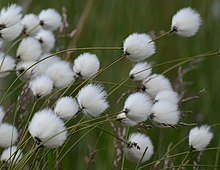Eriophorum
| Eriophorum | |
|---|---|

| |
| Eriophorum vaginatum | |
| Scientific classification | |
| Kingdom: | Plantae |
| Clade: | Tracheophytes |
| Clade: | Angiosperms |
| Clade: | Monocots |
| Clade: | Commelinids |
| Order: | Poales |
| Family: | Cyperaceae |
| Genus: | Eriophorum L. |
| Type species | |
| Eriophorum vaginatum L.
| |
| Synonyms [1] | |
| |
Eriophorum (cottongrass, cotton-grass or cottonsedge) is a genus of flowering plants in the family Cyperaceae, the sedge family. They are found throughout the arctic, subarctic, and temperate portions of the Northern Hemisphere in acid bog habitats, being particularly abundant in Arctic tundra regions.[2][3][4][5]
They are herbaceous perennial plants with slender, grass-like leaves. The seed heads are covered in a fluffy mass of cotton-like fibers which are carried on the wind to aid dispersal. In cold Arctic regions, these masses of translucent fibres also serve as 'down' – increasing the temperature of the reproductive organs during the Arctic summer by trapping solar radiation.[6]
Paper and the wicks of candles have been made of its fiber, and pillows stuffed with the same material. The leaves were formerly used in treating diarrhea, and the spongy pith of the stem for the removal of tapeworm.[7]
Selected species[]
These species are included:[5][1]
- Eriophorum angustifolium Honck. – widespread across Europe, Asia, North America
- Raymond – Alaska including Aleutians; Magadan region of Russia (hybrid E. angustifolium × E. chamissonis)
- Eriophorum brachyantherum Trautv. & C.A.Mey. – Scandinavia, northern Russia, Mongolia, Korea, Alaska, northern Canada
- Eriophorum callitrix Cham. ex C.A.Mey. – Siberia, Russian Far East, Alaska, Canada, Greenland, Montana, Wyoming
- Eriophorum chamissonis C.A.Mey. – Siberia, Russian Far East, Korea, Mongolia, Alaska, Canada, Greenland, northern and western United States
- (A.Gray) Beetle – Oregon, northwestern California
- (Fernald) M.S.Novos. – Ontario, Maine, Massachusetts (hybrid E. virginicum × E. viridicarinatum)
- Eriophorum gracile Koch – much of Europe; northern and Central Asia; China, Tibet, Mongolia, Alaska, Canada, northern United States
- M.S.Novos. – European Russia (hybrid E. gracile × E. latifolium)
- Turcz. – Altai, Tuva, Kazakhstan, Mongolia, Amur
- Eriophorum latifolium Hoppe – much of Europe; Caucasus, Turkey, Mongolia
- Andersson – scattered locations in Finland, Norway, Russia, Alaska, Quebec, Labrador (hybrid E. chamissonis × E. scheuchzeri)
- Beauverd – France (hybrid E. angustifolium × E. vaginatum)
- Raymond – scattered locations in Canada and Alaska (hybrid E. chamissonis × E. vaginatum)
- Raymond – Alaska, Quebec (hybrid E. angustifolium × E. scheuchzeri)
- (Beetle) Raymond – Vietnam
- Eriophorum scheuchzeri Hoppe – much of Europe; northern and Central Asia including Siberia, Xinjiang, Himalayas, Alaska, Greenland, Canada, mountains of western United States
- Nutt. – eastern Canada and northeastern United States from Nunavut and Labrador to New Jersey
- M.S.Novos. – Krasnoyarsk, Yakutiya
- Raymond – Guizhou
- Eriophorum vaginatum L. – most of genus range
- L. – eastern North America from Labrador to Tennessee, west to Michigan
- Eriophorum viridicarinatum (Engelm.) Fernald – Canada including Arctic territories; northern United States
References[]
- ^ a b "Eriophorum L., Sp. Pl.: 52 (1753)". eMonocot. Archived from the original on January 3, 2014. Retrieved May 10, 2013.
- ^ Ball, Peter W. & Daniel E. Wujek (2002). "Eriophorum Linnaeus, Sp. Pl. 1: 52. 1753; Gen. Pl. ed. 5, 27. 1754". In Flora of North America Editorial Committee (ed.). Cyperaceae. Flora of North America North of Mexico. 23. Oxford University Press. pp. 21–27. ISBN 978-0-19-515207-4.
- ^ Flora Europaea: Eriophorum
- ^ Flora of China, Vol. 23 Page 174, 羊胡子草属 yang hu zi cao shu, Eriophorum Linnaeus, Sp. Pl. 1: 52. 1753.
- ^ a b Kew World Checklist of Selected Plant Families
- ^ Crawford, R. M. M. (1989). Studies in Plant Survival. Blackwell Science. pp. 54–55.
- ^ This article incorporates text from a publication now in the public domain: . Collier's New Encyclopedia. 1921.
- Eriophorum
- Cyperaceae genera
- Taxa named by Carl Linnaeus